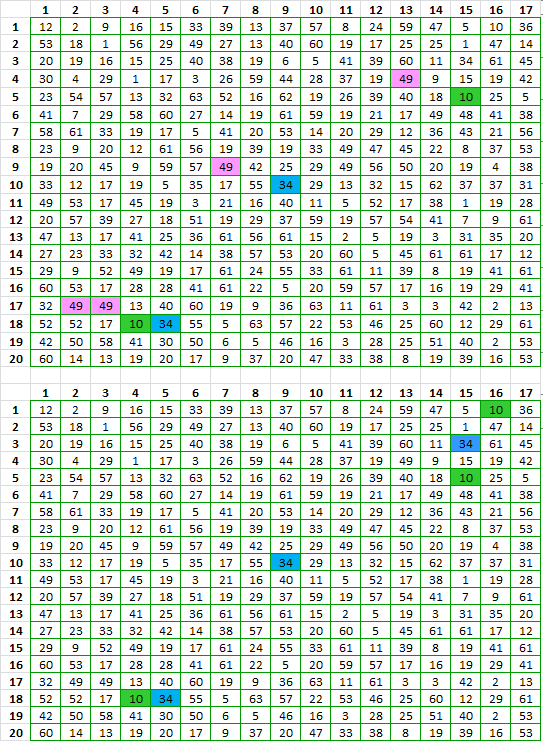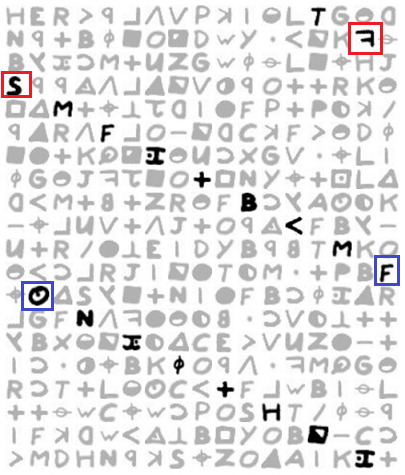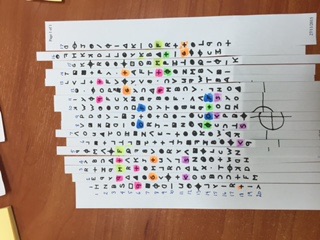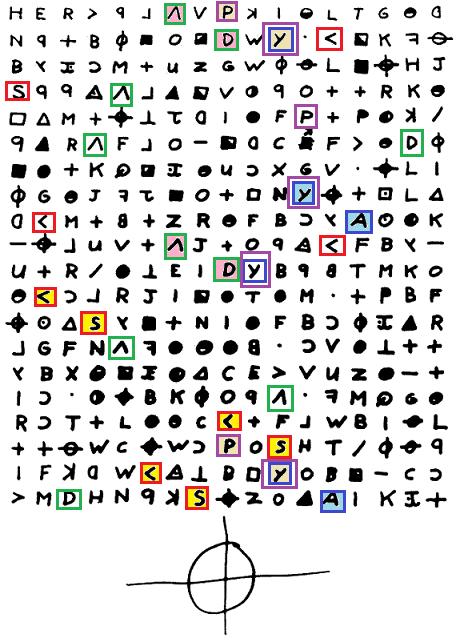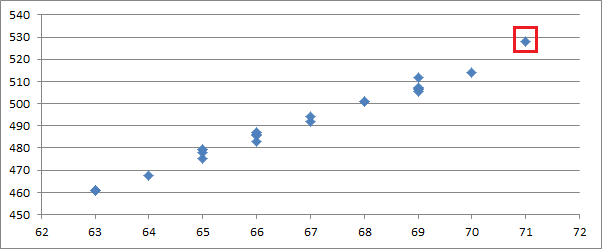I’m starting to get some results from my transposition explorer.
It discovered another way to yield 41 bigram repeats, and applies quadrants to bring the count up to 46 bigram repeats, with 4 trigram repeats (by comparison, the original 340 has only 25 bigram repeats and 2 trigram repeats).
Scroll through the following to see how the transpositions are being applied, and the effect each step has on ngram repeats:
Original Z340: HER>pl^VPk|1LTG2d Np+B(#O%DWY.<*Kf) By:cM+UZGW()L#zHJ Spp7^l8*V3pO++RK2 _9M+ztjd|5FP+&4k/ p8R^FlO-*dCkF>2D( #5+Kq%;2UcXGV.zL| (G2Jfj#O+_NYz+@L9 d<M+b+ZR2FBcyA64K -zlUV+^J+Op7<FBy- U+R/5tE|DYBpbTMKO 2<clRJ|*5T4M.+&BF z69Sy#+N|5FBc(;8R lGFN^f524b.cV4t++ yBX1*:49CE>VUZ5-+ |c.3zBK(Op^.fMqG2 RcT+L16C<+FlWB|)L ++)WCzWcPOSHT/()p |FkdW<7tB_YOB*-Cc >MDHNpkSzZO8A|K;+ 25 bigram repeats. 2 trigram repeats. After flipping vertically: >MDHNpkSzZO8A|K;+ |FkdW<7tB_YOB*-Cc ++)WCzWcPOSHT/()p RcT+L16C<+FlWB|)L |c.3zBK(Op^.fMqG2 yBX1*:49CE>VUZ5-+ lGFN^f524b.cV4t++ z69Sy#+N|5FBc(;8R 2<clRJ|*5T4M.+&BF U+R/5tE|DYBpbTMKO -zlUV+^J+Op7<FBy- d<M+b+ZR2FBcyA64K (G2Jfj#O+_NYz+@L9 #5+Kq%;2UcXGV.zL| p8R^FlO-*dCkF>2D( _9M+ztjd|5FP+&4k/ Spp7^l8*V3pO++RK2 By:cM+UZGW()L#zHJ Np+B(#O%DWY.<*Kf) HER>pl^VPk|1LTG2d 29 bigram repeats. 2 trigram repeats. After applying column period 2: >DNkzOAK+MHpSZ8|; |kW7BYB-cFd<t_O*C +)CWPST(p+WzcOH/) RTL6<FW|Lc+1C+lB) |.zKO^fq2c3B(p.MG yX*4C>U5+B1:9EVZ- lF^54.Vt+GNf2bc4+ z9y+|Fc;R6S#N5B(8 2cR|54.&F<lJ*TM+B UR5EDBbMO+/t|YpTK -lV^+p<B-zU+JO7Fy dMbZ2By6K<++RFcA4 (2f#+Nz@9GJjO_Y+L #+q;UXVz|5K%2cG.L pRFO*CF2(8^l-dk>D _Mzj|F+4/9+td5P&k Sp^8Vp+R2p7l*3O+K B:MUG(LzJyc+ZW)#H N+(ODY<K)pB#%W.*f HRp^P|LGdE>lVk1T2 26 bigram repeats. 2 trigram repeats. Applied diagonal, starting at upper left corner, and reading from upper right to lower left: >D|Nk+kW)Rz7CT|OB WL.yAYP6zXlKBS<K* Fz+-TFO4^92Mc(W^C 5ycUHFp|f>4+RR-pd +LqU.||5ldS<Wc25V F5EVM(Ztz+c+tc4D^ b2#8_c13B+;.B+Zf+ p|OOCB1GR&bp2#qR_ ;*H+(:N6FM<B+;FMS C/lp9fS<OByNUOzpB )B.E2#l+-6zX*j^:N )MVbNJ/zK@VC|8M+H GZc5*tU<9zFFVU(R- 4BT|++G|2+pGOp+(M YJ+J5(4+(D^8+pORj K8/RLYPBT7FO%^92z <|KFc_2l+pJKLyAYc -t7y)G4+GddlcpdL. k5*+BEL>P3Z#>D&OW %lk+)WVK#.kH*1fT2 41 bigram repeats. 4 trigram repeats. Operation: Quadrants(2, 4, 2, 1, 0 [0, 0, 0, 0, 0, 0, 0, 0, 0]) Quadrant 1: >D|N WL.y Quadrant 2: k+kW)Rz7CT|OB AYP6zXlKBS<K* Quadrant 3: Fz+- 5ycU +LqU F5EV b2#8 p|OO ;*H+ C/lp )B.E )MVb GZc5 4BT| YJ+J K8/R <|KF -t7y k5*+ %lk+ Quadrant 4: TFO4^92Mc(W^C HFp|f>4+RR-pd .||5ldS<Wc25V M(Ztz+c+tc4D^ _c13B+;.B+Zf+ CB1GR&bp2#qR_ (:N6FM<B+;FMS 9fS<OByNUOzpB 2#l+-6zX*j^:N NJ/zK@VC|8M+H *tU<9zFFVU(R- ++G|2+pGOp+(M 5(4+(D^8+pORj LYPBT7FO%^92z c_2l+pJKLyAYc )G4+GddlcpdL. BEL>P3Z#>D&OW )WVK#.kH*1fT2 Putting quadrants in new order [1, 3, 2, 4]: Quadrant 1: >D|N WL.y Quadrant 2: Fz+- 5ycU +LqU F5EV b2#8 p|OO ;*H+ C/lp )B.E )MVb GZc5 4BT| YJ+J K8/R <|KF -t7y k5*+ %lk+ Quadrant 3: k+kW)Rz7CT|OB AYP6zXlKBS<K* Quadrant 4: TFO4^92Mc(W^C HFp|f>4+RR-pd .||5ldS<Wc25V M(Ztz+c+tc4D^ _c13B+;.B+Zf+ CB1GR&bp2#qR_ (:N6FM<B+;FMS 9fS<OByNUOzpB 2#l+-6zX*j^:N NJ/zK@VC|8M+H *tU<9zFFVU(R- ++G|2+pGOp+(M 5(4+(D^8+pORj LYPBT7FO%^92z c_2l+pJKLyAYc )G4+GddlcpdL. BEL>P3Z#>D&OW )WVK#.kH*1fT2 No flips or rotations were applied to any quadrant. After concatenation operations [(A concat-right-top B) concat-down (C concat-right-top D)]: >D|NFz+-WL.y5ycU+ LqUF5EVb2#8p|OO;* H+C/lp)B.E)MVbGZc 54BT|YJ+JK8/R<|KF -t7yk5*+%lk+k+kW) Rz7CT|OBTFO4^92Mc (W^CAYP6zXlKBS<K* HFp|f>4+RR-pd.||5 ldS<Wc25VM(Ztz+c+ tc4D^_c13B+;.B+Zf +CB1GR&bp2#qR_(:N 6FM<B+;FMS9fS<OBy NUOzpB2#l+-6zX*j^ :NNJ/zK@VC|8M+H*t U<9zFFVU(R-++G|2+ pGOp+(M5(4+(D^8+p ORjLYPBT7FO%^92zc _2l+pJKLyAYc)G4+G ddlcpdL.BEL>P3Z#> D&OW)WVK#.kH*1fT2 45 bigram repeats. 4 trigram repeats. After flipping vertically: D&OW)WVK#.kH*1fT2 ddlcpdL.BEL>P3Z#> _2l+pJKLyAYc)G4+G ORjLYPBT7FO%^92zc pGOp+(M5(4+(D^8+p U<9zFFVU(R-++G|2+ :NNJ/zK@VC|8M+H*t NUOzpB2#l+-6zX*j^ 6FM<B+;FMS9fS<OBy +CB1GR&bp2#qR_(:N tc4D^_c13B+;.B+Zf ldS<Wc25VM(Ztz+c+ HFp|f>4+RR-pd.||5 (W^CAYP6zXlKBS<K* Rz7CT|OBTFO4^92Mc -t7yk5*+%lk+k+kW) 54BT|YJ+JK8/R<|KF H+C/lp)B.E)MVbGZc LqUF5EVb2#8p|OO;* >D|NFz+-WL.y5ycU+ 46 bigram repeats. 4 trigram repeats. Full Sequence: FlipVertical() PeriodColumn(2) Diagonal(1) Quadrants(2, 4, 2, 1, 0 [0, 0, 0, 0, 0, 0, 0, 0, 0]) FlipVertical() And here are the top 50 repeating patterns, sorted by probability: Length Probability Count Pattern Positions 8 1.955061834604852E-20 2 FO?^92?c [60, 247] 6 2.260051480803209E-17 2 FO?^92 [60, 247] 7 2.26005148080321E-17 2 O?^92?c [61, 248] 5 2.61261951180851E-14 2 ^92?c [63, 250] 5 2.6126195118085105E-14 2 O?^92 [61, 248] 5 3.225456187417913E-14 2 FO?^9 [60, 247] 8 6.688305950229784E-14 2 B+;????f [140, 179] 8 1.5048688388017016E-13 2 ^????B+; [135, 174] 3 1.8876175972816484E-12 2 6zX [130, 228] 2 8.94870564637226E-12 3 S< [148, 189, 234] 3 3.0201881556506375E-11 2 ^92 [63, 250] 9 3.1330827060504736E-11 2 f??????pd [14, 208] 4 3.728627352655109E-11 2 O?^9 [61, 248] 8 4.110811656302256E-11 2 <????V?( [86, 190] 9 4.71904399320412E-11 2 2#??????* [125, 314] 7 5.369223387823354E-11 2 +;????f [141, 180] 2 5.898804991505152E-11 3 2# [125, 162, 314] 4 8.389411543473992E-11 2 92?c [64, 251] 6 1.0357298201819742E-10 2 R-???| [94, 213] 2 1.3982352572456658E-10 3 BT [57, 245, 274] 4 2.3303920954094423E-10 2 FO?^ [60, 247] 6 3.314335424582318E-10 3 R????| [94, 213, 238] 5 4.719043993204121E-10 3 O???2 [61, 121, 248] 6 4.719043993204121E-10 3 F????2 [60, 247, 309] 3 4.83230104904102E-10 2 B+; [140, 179] 4 6.281047554954685E-10 3 2??p [35, 65, 314] 6 6.344492479752207E-10 2 2??p?O [65, 314] 9 6.344492479752209E-10 2 F????2??p [60, 309] 7 6.57729865008361E-10 2 V?(???+ [91, 195] 9 9.32156838163777E-10 2 +????y??c [37, 329] 9 1.0872677360342291E-9 2 z??V????+ [88, 107] 2 1.9329204196164076E-9 3 4+ [48, 77, 210] 7 1.932920419616408E-9 2 ^????B+ [135, 174] 5 3.0694060367056848E-9 3 (???+ [79, 93, 197] 5 3.728627352655108E-9 2 |?F?+ [286, 325] 9 4.5116390967126826E-9 2 |???+???p [207, 286] 2 4.7892146885214484E-9 2 AY [43, 225] 2 7.483147950814765E-9 2 :N [102, 168] 5 8.948705646372261E-9 3 |???+ [207, 286, 325] 9 8.948705646372261E-9 3 +???????c [37, 184, 329] 2 1.0775733049173263E-8 2 YP [55, 226] 6 1.0775733049173263E-8 2 ;????f [142, 181] 2 1.546336335693126E-8 3 B+ [140, 179, 183] 2 2.4245399360639836E-8 2 zX [131, 229] 2 2.4245399360639836E-8 2 Vb [301, 312] 3 2.4245399360639836E-8 2 L?P [27, 54] 9 3.300068246309311E-8 2 /???????M [106, 292] 2 4.310293219669305E-8 2 D^ [80, 173] 2 4.310293219669305E-8 2 ^9 [63, 250] 2 4.310293219669305E-8 2 H* [11, 116] One of the measurements I use is to compare Z340's ranked fragments list to the transposed cipher's ranked fragments list (both are sorted by probability). The measurement counts how many entries in the former list are beaten by the corresponding entry in the latter list. In this example, the measurement is 104, so the transposed cipher has many more "interesting" patterns appearing in it than the original Z340.
Note: The "column period 2" operation is similar to applying ngram periods, except it skips entire columns instead of individual symbols. For example, column period 1 is the normal order of columns (1,2,3,4,5,6,7,8,9,10,11,12,13,14,15,16,17). Column period 2 is the order (1,3,5,7,9,11,13,15,17,2,4,6,8,10,12,14,16). So it is a way to interleave the columns. Incidentally, applying a row period of 10 yields the same cipher text that would result from performing Dan Olson’s suggestion (splitting the cipher into two halves and placing them side by side). The new row ordering becomes (1,11,2,12,etc) in both cases.
Here’s a way to produce 44 bigram repeats and 5 trigram repeats without using quadrants:
Original Z340: HER>pl^VPk|1LTG2d Np+B(#O%DWY.<*Kf) By:cM+UZGW()L#zHJ Spp7^l8*V3pO++RK2 _9M+ztjd|5FP+&4k/ p8R^FlO-*dCkF>2D( #5+Kq%;2UcXGV.zL| (G2Jfj#O+_NYz+@L9 d<M+b+ZR2FBcyA64K -zlUV+^J+Op7<FBy- U+R/5tE|DYBpbTMKO 2<clRJ|*5T4M.+&BF z69Sy#+N|5FBc(;8R lGFN^f524b.cV4t++ yBX1*:49CE>VUZ5-+ |c.3zBK(Op^.fMqG2 RcT+L16C<+FlWB|)L ++)WCzWcPOSHT/()p |FkdW<7tB_YOB*-Cc >MDHNpkSzZO8A|K;+ After flipping vertically: >MDHNpkSzZO8A|K;+ |FkdW<7tB_YOB*-Cc ++)WCzWcPOSHT/()p RcT+L16C<+FlWB|)L |c.3zBK(Op^.fMqG2 yBX1*:49CE>VUZ5-+ lGFN^f524b.cV4t++ z69Sy#+N|5FBc(;8R 2<clRJ|*5T4M.+&BF U+R/5tE|DYBpbTMKO -zlUV+^J+Op7<FBy- d<M+b+ZR2FBcyA64K (G2Jfj#O+_NYz+@L9 #5+Kq%;2UcXGV.zL| p8R^FlO-*dCkF>2D( _9M+ztjd|5FP+&4k/ Spp7^l8*V3pO++RK2 By:cM+UZGW()L#zHJ Np+B(#O%DWY.<*Kf) HER>pl^VPk|1LTG2d After applying column period 2: >DNkzOAK+MHpSZ8|; |kW7BYB-cFd<t_O*C +)CWPST(p+WzcOH/) RTL6<FW|Lc+1C+lB) |.zKO^fq2c3B(p.MG yX*4C>U5+B1:9EVZ- lF^54.Vt+GNf2bc4+ z9y+|Fc;R6S#N5B(8 2cR|54.&F<lJ*TM+B UR5EDBbMO+/t|YpTK -lV^+p<B-zU+JO7Fy dMbZ2By6K<++RFcA4 (2f#+Nz@9GJjO_Y+L #+q;UXVz|5K%2cG.L pRFO*CF2(8^l-dk>D _Mzj|F+4/9+td5P&k Sp^8Vp+R2p7l*3O+K B:MUG(LzJyc+ZW)#H N+(ODY<K)pB#%W.*f HRp^P|LGdE>lVk1T2 After flipping horizontally: ;|8ZSpHM+KAOzkND> C*O_t<dFc-BYB7Wk| )/HOczW+p(TSPWC)+ )Bl+C1+cL|WF<6LTR GM.p(B3c2qf^OKz.| -ZVE9:1B+5U>C4*Xy +4cb2fNG+tV.45^Fl 8(B5N#S6R;cF|+y9z B+MT*Jl<F&.45|Rc2 KTpY|t/+OMbBDE5RU yF7OJ+Uz-B<p+^Vl- 4AcFR++<K6yB2ZbMd L+Y_OjJG9@zN+#f2( L.Gc2%K5|zVXU;q+# D>kd-l^8(2FC*OFRp k&P5dt+9/4+F|jzM_ K+O3*l7p2R+pV8^pS H#)WZ+cyJzL(GUM:B f*.W%#Bp)K<YDO(+N 2T1kVl>EdGL|P^pRH After applying period 18: ;*H+(:N6FM<B+;FMS fT|OOCB1GR&bp2#qR _H*18_c13B+;.B+Zf +pK#.kZtz+c+tc4D^ b2#k+)WVS<Wc25VF5 EVM(D&OW%lpd+LqU. ||5ldL>P3Z#>HFp|f >4+RR-L.k5*+BEMc( W^C5ycU4+Gddlcpd+ -TFO4^92yAYc-t7y) GKBS<K*FzKFc_2l+p JKLAYP6zXlBT7FO%^ 92z<|OBWL.y8+pORj K8/RLYPz7CT|+(MYJ +J5(4+(D^kW)R-4BT |++G|2+pGOpNk+GZc 5*tU<9zFFVU(RD|)M VbNJ/zK@VC|8M+H>) B.E2#l+-6zX*j^:NC /lp9fS<OByNUOzpB2 44 bigram repeats 5 trigram repeats Top 50 fragments: Length Probability Count Pattern Positions 6 2.260051480803209E-17 2 FO?^92 [155, 200] 9 7.744320305990411E-15 2 5???(D??W [84, 240] 5 2.6126195118085105E-14 2 O?^92 [156, 201] 5 3.225456187417913E-14 2 FO?^9 [155, 200] 3 1.8876175972816484E-12 2 6zX [193, 314] 8 4.644656909881795E-12 2 T|+????+ [231, 254] 2 8.94870564637226E-12 3 S< [76, 173, 328] 8 1.3988178552695176E-11 2 5???E??( [81, 128] 5 1.8270274028010024E-11 2 (D??W [88, 244] 6 2.4867872982569208E-11 2 5???(D [84, 240] 2 2.7200968727031756E-11 4 +p [51, 185, 216, 261] 3 3.0201881556506375E-11 2 ^92 [158, 203] 8 3.7286273526551075E-11 2 S<?????F [76, 173] 4 3.728627352655109E-11 2 O?^9 [156, 201] 9 4.1108116563022564E-11 2 (?^?????4 [135, 244] 9 4.7959469323526324E-11 3 (???????4 [135, 234, 244] 9 4.7959469323526324E-11 3 5???????W [84, 128, 240] 2 5.898804991505152E-11 3 2# [30, 69, 309] 2 8.091639220171676E-11 3 T| [18, 231, 254] 8 8.389411543473992E-11 2 6???B??F [7, 193] 3 1.0193135025320899E-10 3 ^?2 [67, 158, 203] 4 2.3303920954094423E-10 2 FO?^ [155, 200] 9 2.923243844481605E-10 2 Y??????+( [226, 236] 5 4.719043993204121E-10 3 O???2 [156, 201, 335] 3 4.83230104904102E-10 2 B+; [11, 43] 8 5.965803764248172E-10 2 R-?????+ [123, 250] 4 7.550470389126592E-10 2 2#?+ [69, 309] 9 7.550470389126592E-10 2 +??????2# [62, 302] 9 7.550470389126594E-10 2 B???O???2 [197, 331] 3 9.32156838163777E-10 2 T|+ [231, 254] 3 1.1279097741781702E-9 2 pd+ [95, 150] 8 1.3423058469558393E-9 2 +???c??^ [60, 130] 2 1.9329204196164076E-9 3 4+ [120, 143, 242] 2 1.9329204196164076E-9 3 +G [144, 257, 268] 6 1.9329204196164076E-9 3 .????+ [46, 55, 307] 8 1.9329204196164076E-9 3 +??????^ [60, 130, 312] 2 3.0694060367056848E-9 3 +( [3, 233, 243] 8 3.0694060367056848E-9 3 +??????5 [97, 121, 233] 2 4.7892146885214484E-9 2 AY [162, 190] 9 4.7892146885214484E-9 2 3???????f [42, 110] 2 7.483147950814765E-9 2 :N [5, 320] 2 1.0775733049173263E-8 2 YP [191, 226] 2 1.546336335693126E-8 3 B+ [11, 43, 47] 3 1.6837082889333224E-8 2 N?/ [291, 321] 7 2.147689355129343E-8 2 |+????+ [232, 255] 2 2.4245399360639836E-8 2 zX [194, 315] 3 2.4245399360639836E-8 2 L?P [107, 225] 8 2.4245399360639836E-8 2 b??????V [68, 290] 9 2.5987041197065044E-8 2 +???+???p [44, 257] 8 2.993259180325906E-8 2 k??????t [56, 267]
Note that this one doesn’t use diagonals. But it does use period 18, which will follow diagonal paths since each row is 17 symbols wide.
The previous example, which produces 44 bigram repeats and 5 trigram repeats, is made by applying these operations: FlipVertical() PeriodColumn(2) FlipHorizontal() Period(18)
Which results in this cipher text:
;*H+(:N6FM<B+;FMS fT|OOCB1GR&bp2#qR _H*18_c13B+;.B+Zf +pK#.kZtz+c+tc4D^ b2#k+)WVS<Wc25VF5 EVM(D&OW%lpd+LqU. ||5ldL>P3Z#>HFp|f >4+RR-L.k5*+BEMc( W^C5ycU4+Gddlcpd+ -TFO4^92yAYc-t7y) GKBS<K*FzKFc_2l+p JKLAYP6zXlBT7FO%^ 92z<|OBWL.y8+pORj K8/RLYPz7CT|+(MYJ +J5(4+(D^kW)R-4BT |++G|2+pGOpNk+GZc 5*tU<9zFFVU(RD|)M VbNJ/zK@VC|8M+H>) B.E2#l+-6zX*j^:NC /lp9fS<OByNUOzpB2
But a more direct way to visualize that is illustrated here:
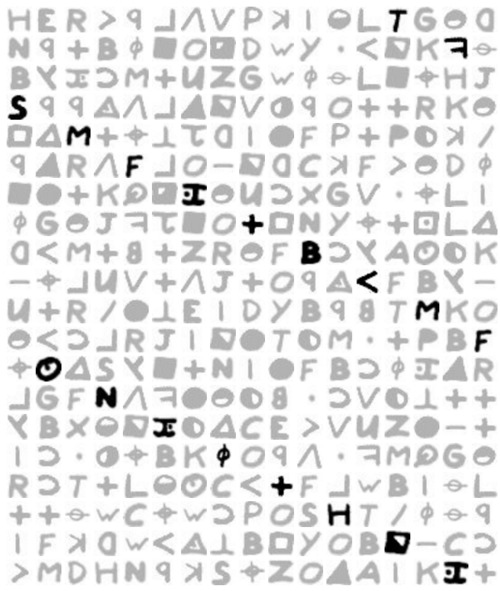
Read from the bottom right towards the upper left.
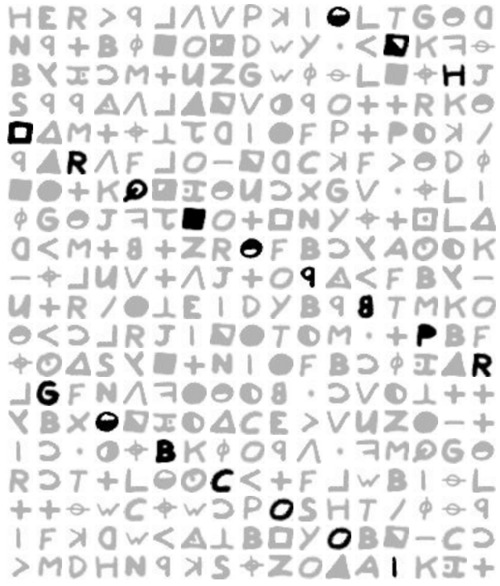
Continue in this way until you have a cipher of length 340
Now, notice that the diagonal wraps around twice. The first time (counting from the bottom up), it does not skip one row. The second time, it does. Could this be related to the "misalignments" you guys have been talking about?
.
With "misalignments" I mean that if Zodiac skipped or added a plaintext when transposing, the untransposed message will have misaligned text. Several skipped or added plaintext would make an untransposed message difficult to solve, even if we knew what the transposition scheme was. Given all of the spelling errors, that is not hard to imagine.
With your examples I see that the upper bigram that goes from the right side to the left side is period 19, but the lower that goes from the right side to the left side is period 2. So maybe you found where a skipped symbol should be. I am not sure.
.
Guys great work so far. I won’t be able to do so much for some days, working saturday and sunday etc.
Now, notice that the diagonal wraps around twice. The first time (counting from the bottom up), it does not skip one row. The second time, it does. Could this be related to the "misalignments" you guys have been talking about?
That’s interesting, I guess that could be related to the misalignment yes. I’m assuming there is one because for the mirrored/flipped 340 period 1 bigram repeats have become period 15 bigrams and period 2 bigram repeats have become period 29 (expected 30). I will be looking at this as soon as possible, thanks for mentioning it.
@smokie, your misalignment heat map is very cool! Very good idea.
Smokie I put this up for the bigram 19 repeats. I’m a bit like Homer Simpson "just looking at the pretty colors" any ways I had been playing mind tetras with the biagram 19 stuff and noticed I could get up a pair of trigrams doing a column shift. So I thought of putting them all in to see what came of it.. Anyways not much more except it only took a few column shifts to park each one next to the other so they all aligned except one. This is a crude set up and hope you can understand what I have done. I haven’t really checked it out and have only spent 20 minutes on it..(busy time for me) and there is a whole bunch of other column shift permutations that may give up something. When I get a moment I’ll do the same on row shifts to see what it delivers. Don’t hang me ..just trying to help.. And Keep up the good work all…
Cheers….
.
Mr. Lowe, it looks like you cut the message into strips and slid the columns up or down to align the period 19 bigram repeats into period 2 bigram repeats. Now all you have to do is rearrange the columns so that they are period 1 bigram repeats. I was messing around with the a few months ago ( have we been talking about the period 19 bigram repeats for that long? ). Look for some type of pattern to the rearrangement. I couldn’t find one but that doesn’t mean that there isn’t one.
By the way, thanks for posting. I really like it when you examine the work here, especially when you separate the words in proposed solutions. If you have any other ideas, let us know.
This morning I woke up thinking about how maybe row 1 is gibberish instead of row 20. He could have skipped any row in a vertical 17×20 transposition and caused the period 19 bigram repeats. I wonder if there is a way to detect that…
I can work on this project for a couple of weeks more and then have visitors for the holidays. I won’t be able to make substantial contributions again until January or so, unless I do it very early in the morning.
.
I think you’ve stumbled upon something very interesting with the column period 2 thing and other that it may be part of the 340’s actual transposition scheme I think that it may also help us to narrow down on "interpretations" (use it as a test). A column period 2 transposition increases bigrams and etc for the 340. A scheme similar to the 340 should show a similar response.
After trying a few small sample tests it seems that the magic square transposition scheme (period x=2) has a positive correlation with your observation. Smokie’s ciphers and regular period schemes tested negative.
I’m not sure if your transposition scheme could cause a "misalignment" (bigram period 15, 29 etc) but it came up negative after applying it to the 408.
.
I have spent a lot of time with the misalignment heat map. It is cool, and works some of the time. I used it to solve smokie12 by using trial and error in a couple of hours. But with some of the other messages that I have made, I wound up making more misalignments instead of repairing them. The heatmap is only useful if there are only a couple of skips or adds, and if by chance the symbols are distributed to correctly show where replacing a skipped plaintext or deleting an extra plaintext would cause an increase in period 19 bigram repeat scores.
The heatmap does work with smokie14 to show where extra symbols should be deleted. After you delete the highest ranked position for a delete and recalculate the heatmap, the other extra symbol that needs to be deleted shows up ranking number 1 as well. Unfortunately I do not see using the heatmap as a cure for this problem. The problem is that with an erroneous delete or add, I just wind up creating more problems than I solve.
I still think that he used a transposition scheme and that the diagonal rows are words. However, I have taken another look at the 340 period 19 repeats, wondering if row 1 may be gibberish or if he may have skipped some row in between. This is a very difficult problem.
Some of the highest scoring period 19 bigram repeats occupy positions in both rows 1 and 20. It could just be a coincidence. But this is some evidence, although I am not sure how weighty, that row 20 is not gibberish. And if he skipped another row somewhere, including row 1 during transposition, or row 2-19, or some type of skipping pattern, then he would have run out of actual plaintext at the end and row 20 would still have been gibberish.
I would have to modify my scheme to simulate this, and am not sure how to do it. At some point I am going to have to make a big spreadsheet with all 100 of Jarlve’s messages and make a random message generator with variables including number of symbols and percentage of efficiency with distribution of symbols on the key. Find out at how many symbols does it become impossible to re-create the number of period 19 bigram repeats without using a transposition scheme. I want to know that.
EDIT: My next project is going to be a new experiment to try to determine whether any of the rows in the 340 are more or less likely to be gibberish, starting with row 20 and row 1.
.
.
Question: Is any particular row more or less likely to be gibberish as compared to the others?
Here is the experiment. Shuffle all of the symbols in one row. Count the number of period 19 repeats in the entire message and total up the scores. See if the count and score goes up or down as compared to the original count and score. Do that 30 times and make a scatter graph for comparison. Do that with all of the rows and compare the scatter graphs between the rows. Interpret the results, see if we learn anything or need to modify the experiment to learn anything.
Here is row 1 for starters. On the x axis is the count of period 19 repeats where A19B A19B count as two. On the y axis is the total of all period 19 repeat scores, where the scores are calculated by taking the natural logarithm of 1/probability. For row 1, the original count of 71 and score of 528 falls on the upper right of the scatter graph:
EDIT: Here is row 2. Of 30 shuffles, one resulted in higher period 19 repeat count and scores:
.
That’s an interesting question smokie.
I made a cipher with a bigram 19 scheme and inserted one random row after encoding. So you have 2 ways to detect it, to give you an easy start.
1 2 3 4 5 6 7 8 9 10 11 12 13 14 15 16 17 18 19 20 5 21 22 23 24 1 25 26 27 28 29 20 30 31 32 7 8 33 34 22 6 13 2 35 23 36 37 38 25 29 11 39 40 9 18 12 24 41 42 5 36 43 21 29 30 3 14 31 44 45 16 34 1 15 26 6 20 46 29 35 17 10 42 27 32 4 13 45 19 12 17 23 12 46 47 25 10 28 7 38 44 9 3 11 2 16 48 17 21 39 35 35 41 33 30 8 37 14 45 22 24 32 46 31 38 2 43 13 40 6 4 49 5 15 11 34 12 19 28 33 39 42 41 37 44 3 16 43 23 18 24 34 1 26 22 36 40 3 27 33 22 37 4 40 21 32 17 19 7 9 47 18 28 10 30 37 38 31 42 39 41 11 40 1 45 7 2 42 23 15 25 11 32 11 8 14 8 42 9 11 16 29 41 47 8 46 43 14 10 15 26 44 45 13 46 16 20 21 5 37 27 9 8 48 47 49 48 5 32 18 29 14 10 1 38 50 4 34 15 11 26 35 19 33 27 28 23 8 7 39 6 5 9 41 43 17 47 25 14 12 24 49 4 36 48 2 30 15 3 13 42 26 22 25 31 36 23 29 27 40 24 33 21 8 19 5 48 32 22 37 48 45 6 28 30 16 44 39 13 3 34 42 18 17 29 31 6 41 43 44 4 14 49 15 38 11 26 20 27 2 30 8 19 16 23 14 46 25 21 49 1 28 32 15 40 35 31 39 41 7 721QJB&0RT9>XF5." S(=J%@$*7,43L#=:V <&0G'@BX26$U[Z,#9 HNRS>*-KJUP%#:1FV C.'754B=+#6"TK3< QXC(>"$>+I,TL&ZR 192.W"%H66-G:0[FC @*<+VZ2PXNBQ)J59' >(LGHK-[1.P$S*'7 4@UN13G@[QN%<"(&R ISLT:[ZVKH-9N7C&2 K$5,9<90F0KR9.#-I 0+PFT54CX+.=%J[3 R0WI)WJ<S#FT7Z;Q' 5946(G3L$0&HBJR-P "I,F>*)QUW2:51XK4 @,VU$#3N*G%0(JW<@ [WCBL:.HX1'KS"#V B-PQF)5Z94=32:0( .$F+,%)7L<5N6VH-&
I found a simple 2 part transposition for the 340 that yields 45 bigrams and 4 trigrams.
Column right shift by 1: dHER>pl^VPk|1LTG2 )Np+B(#O%DWY.<*Kf JBy:cM+UZGW()L#zH 2Spp7^l8*V3pO++RK /_9M+ztjd|5FP+&4k (p8R^FlO-*dCkF>2D |#5+Kq%;2UcXGV.zL 9(G2Jfj#O+_NYz+@L Kd<M+b+ZR2FBcyA64 --zlUV+^J+Op7<FBy OU+R/5tE|DYBpbTMK F2<clRJ|*5T4M.+&B Rz69Sy#+N|5FBc(;8 +lGFN^f524b.cV4t+ +yBX1*:49CE>VUZ5- 2|c.3zBK(Op^.fMqG LRcT+L16C<+FlWB|) p++)WCzWcPOSHT/() c|FkdW<7tB_YOB*-C +>MDHNpkSzZO8A|K; Undo period 19: dpclddG+4Ucy5C^W( +H+M8|CV@-+l#2E.B )>EB+*5k.L-RR+4>f |cMR(UVFFzKz/JNbV M)|D>#Z3P>Ldl5||. UqpFHpOGp+29<Ut*5 cZG+kNl%WO&D(MVE5 FV5L+dp^D(+4|G++| TB4-R)WkVW)+k#2b^ D4ct2cW<SPYLR(5J+ JYM(+|TC7zk.#Kp+f Z+B.;+c+ztZ|<z/8K jROp+8y.LWBO1*H_R q#2pb&+B31c_8LK29 ^%OF7TBlXz6PYATfS MF;+B<MRG1BCOO|GJ p+l2_cFKzF*K<SBK2 BpzOUNyBF6N:(+H*; )y7t-cYAy29^4OFT- N:^j*Xz6O<Sf9pl/C
Jarlve, can you give me numbers instead of symbols? EDIT: See the post above for rows 1-2 and row 3 coming up soon. I will continue my work but it may take a while because I do stuff manually.
Also, I am wondering if the multiplicity of the cipher text (# of unique symbols divided by cipher length) can be a rough prediction of the expected number of repeated ngrams (when compared to the 408).
I’ve found a better measure. For every unique symbol in the cipher: score+=symbol_frequency*(symbol_frequency-1). A higher score = more potential for repeating fragments etc. By this measurement, scores:
340: 2236
408 (capped 340): 2108
So, on average we should find more bigrams and etc in the 340 than in the 408 (capped 340).
@smokie, I added a numerical version. Is your spreadsheet okay with 50 symbols?
I’ve found a better measure. For every unique symbol in the cipher: score+=symbol_frequency*(symbol_frequency-1). A higher score = more potential for repeating fragments etc.
Basically the same as Friedman’s "Index of Coincidence" then, just used differently, hmmm.
-glurk
——————————–
I don’t believe in monsters.

